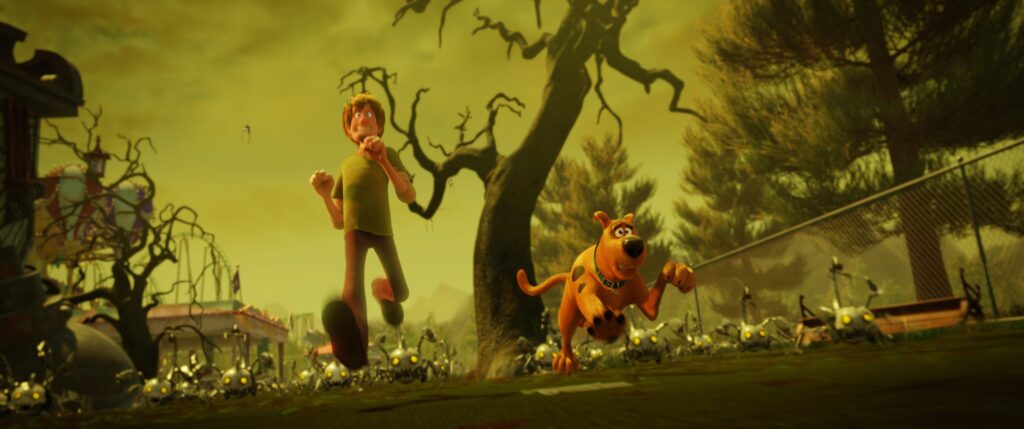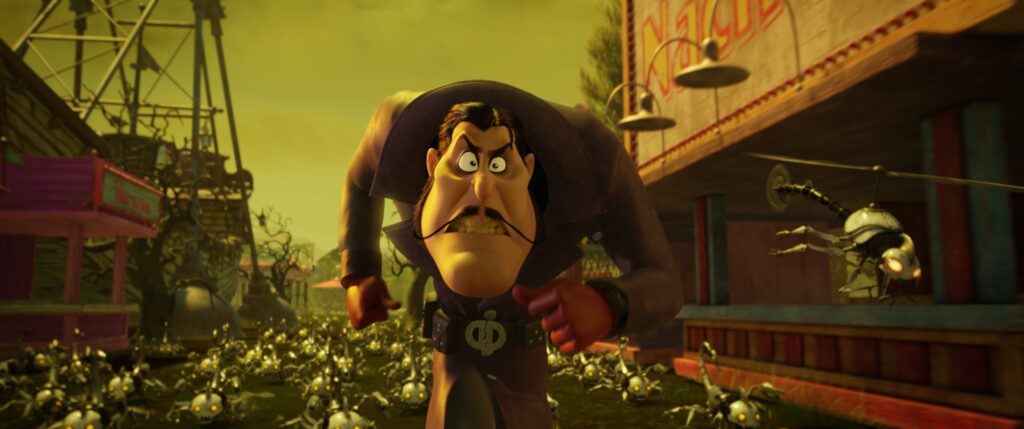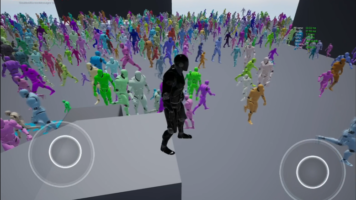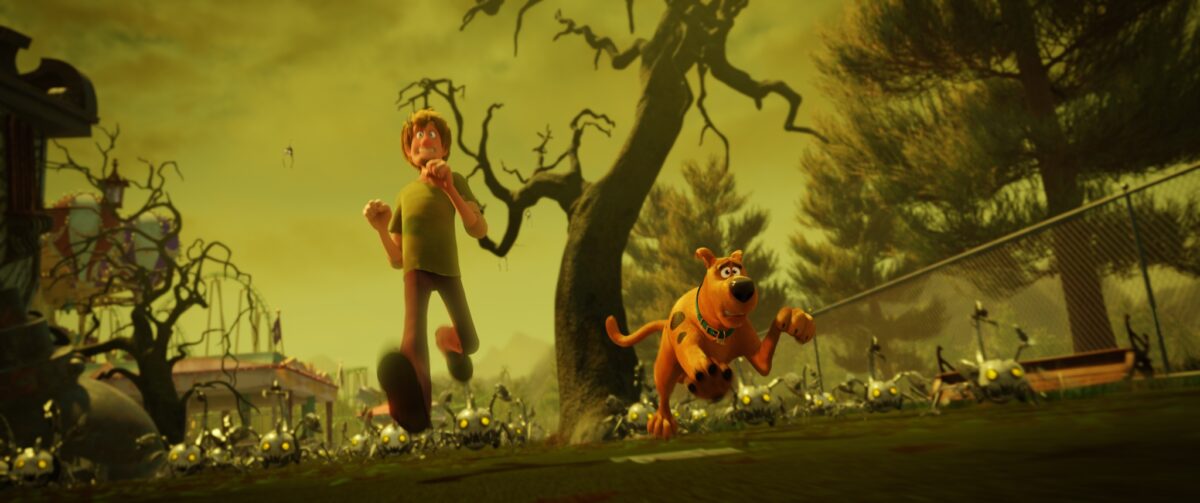Reel FX populates "Scoob!" with Atoms Crowd
07/01/2021

Reel FX is one of the early adopters of Atoms Crowd.
Today we have a chat with Philip Melancon (Former Reel FX Crowd supervisor) and Guy Dubost (Reel FX Lead TD) to talk about how Reel FX uses Atoms Crowd to create their crowd sequences for "Scoob!".

Hello Philip and Guy, can you please introduce yourself?
Philip: Hi Daniele and Alan! We’re really excited to talk about some of what we’ve been working on since we adopted Atoms as our main crowd solution.
My name is Philip Mélançon and I am the crowd animation supervisor for ReelFX’s feature film division. I’ve been working in the VFX/animation industry for about 13 years and have worn a bunch of different hats depending on production needs. While I’ve spent some time as a pipeline TD, FX/CFX artist, and animation TD, most of my time has been spent working as an animator and crowd TD. My first introduction to the world of crowd simulation came about when the studio I worked for vastly underestimated the scope of work needed to add hundreds of crows flying around in a few sequences. Not wanting to hand animate all of those birds, I ended up writing a primitive crowd solution based on Softimage’s ICE architecture. I’ve since had the chance to work on a wide variety of projects and styles, including armies of undead soldiers for Thor:Ragnarok, happy families exploring the amusement park in Dumbo, fearless knights in Arthur:Legend of the Sword, colorful fish in Mary Poppins Returns, etc.
For the past 2 years, I’ve been working at ReelFX and originally started as a lead animator for background characters. With productions being more and more demanding, I eventually ended up taking on crowds as well and now supervise both the animation of background characters and larger crowd simulations.
Guy: Hi there !
My name is Guy Dubost, I am Pipeline Lead in the CG Film branch at ReelFX.
I have been supervising our TDs who did a tremendous job at implementing Atoms into our pipeline.
Can you please tell us why you chose Atoms among all the other available software?
Philip: One of our main objectives at ReelFX is to have our secondary characters and crowds be as indistinguishable from our main characters as possible quality-wise. In the past, we often relied on instanced animation caches and while that has a lot of advantages with regards to rendering speed, it also has the drawback of being stuck with the original animation. Our projects are constantly growing in scope and we needed a skeleton-based solution. Having worked with most commercial solutions out there, I was really interested in Atoms because of how easily customizable it can be.
Another thing that was really important to us was the fact that it’s extremely easy to pick up. As anyone in this business knows, studios tend to hold on to the crowd artists that they have and so the ability to quickly train people to use the software was critical to us in formally establishing a new department.
The final deciding factor for me personally was the extensive Python API and how easy it can be to write custom behaviors.
Is there any particular feature and workflow you like about our software after having used it in production?
Philip: As I just mentioned, for me the ability to write custom Python behaviors is a game changer. This opens up so many possibilities without requiring a software update. We had a lot of very specific scenarios to solve on the projects we worked on and even if there wasn’t an obvious solution out of the box, we could still quickly whip up a solution that exactly fit our needs.

How many shots did you deliver for "Scoob!"? Which ones were the most challenging?
Philip: Scoob had a total of 184 crowd shots. The biggest challenge was probably how diverse all of the different crowd scenarios were. We had shots of people taking it easy on Venice Beach, hundreds of murderous robots flying through the air or scuttling on the ground trying to capture Shaggy & Scooby, thousands of cave-people cheering on Captain Caveman in his fight against Blue Falcon and the gang, adorable little robots being terrorized by Dick Dastardly, tourists marveling before ancient Greece appearing before their eyes - and subsequently running for their lives and, finally, a giant rave on the streets of Venice Beach to bring things full circle.
This meant managing hundreds of different assets, cycles, looks, etc., while simultaneously integrating a new software into our pipeline. Thankfully, we have a great team and Atoms has a lot of ways to make their lives easier by being able to fully or partially re-use existing simulations through cacheReaders, or simply duplicating proxies and swapping variation files.
How many artists are working on your team? Do you think Atoms scales well following your production needs?
Philip: Our team was composed of 3 crowd artists, 7 BG animators, 1 animation lead, 1 pipeline TD, as well as myself and our production staff.
Our production timeline for the crowd shots on Scoob was approximately 15 weeks long. This means an output of about 4 shots per week per crowd artist. Due to how versatile and flexible Atoms is, we got to spend our time on the shots that deserved more attention and re-use on ones where we could get away with it. For example, almost every shot of Venice Beach that we see in the film reuses the same cache with minor modifications. These critical time gains let us, for example, develop a custom overlap system for our flying robots’ tail so that we could art direct them zipping around without the need for our animators to provide us with dozens of different cycles to cover every potential trajectory, but also without the added cost of doing actual physics simulations. For some of our assets, it even ended up being more cost effective to do even close up secondary characters through Atoms instead of hand animating them, so that let us add more time in animation to provide more cycles and add more custom animations in other shots where we’d benefit from one-offs.
We know you did some python coding on top of Atoms. How easy was to extend it and shape it to fit your needs?
Philip: We wrote a few custom behaviors for Atoms. We found it extremely easy to just “sketch out” ideas through python behaviors and adjust as needed. The fact that the API gives you access to almost everything the engine does under the hood means that you’re generally limited by your own imagination or abilities more than by the software. The examples provided on the website were also a very good starting point for us to explore new ideas.
Guy: We also did some extra coding to automate a lot of rigging and lighting related tasks. For example, we faced a motion blur issue with Arnold related to the number of geometries called in a single instance. Since a lot of these shots were already completed in crowds, we simply wrote a script that would read the cache IDs, and split up the crowd into multiple proxies containing a fraction of the complete crowd. That way lighting artists could split up a proxy easily directly in their scenes without having to kick it back upstream. We also leveraged the existing Atoms dialogs when building our pipeline and simply forced standardized paths instead of leaving them open to user input. That way the existing docs from your website are still relevant, but we ensure a certain standard in our file management system.
We hit a few walls along the way in some areas, but the Toolchefs team was always quick to provide us with a solution or propose an alternative to get us where we needed to go.

Can you briefly outline your pipeline and how easy it was to integrate Atoms Crowd into it?
Guy: Our biggest challenge was converting our complex animation rigs to something Atoms could work with. Since our goal is to strive for the highest possible quality, we tried to keep as many of the bells and whistles that our rigs have as we could. This meant writing a few custom tools to port our correctives system so that we had the option to get high quality deformation when we were close enough to camera to need it.
Another complex hurdle was translating our existing variant system to Atoms variations. We decided to stick with existing assets and looks and so needed to make sure we could have a 1:1 match for every character had. The fact that Atoms variations are built around json files helped us a lot in that regard. We just needed to collect and output the information the correct way.
Ultimately, those were the only critical bridges that we needed to build. For everything else, we more or less relied on the native Atoms toolset. We’ve since added more automation into our pipeline for other projects but those were the critical pieces that were built while working on “Scoob!”
Is there anything else you would like to add?
Philip: Toolchefs has been a great partner for us. Anytime we’ve faced a problem, the response and turnaround time has been incredible and I’m excited to see what Atoms 4.0 bring to the table. We’ve completed 2 projects with Atoms so far - WB’s Scoob! and Paramount’s Rumble - with a third currently in production - Netflix’s Back to the Outback - with a few more productions slated to begin next year.




